As I mentioned in my review of Raven’s of Thri Sahashri, while I thoroughly enjoyed it the learning curve is sizable. The two player roles are quite different, and with unique gameplay revolving around non-verbal communication strategies for neither role are immediately apparent nor intuitive.
This is not meant as a complete substitute for the rulebook, but hopefully will be a useful gameplay guide to help make the complicated rule structure more accessible and supply a few strategy hints to help new players from feeling too overwhelmed.
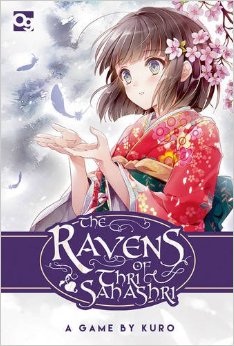
Overview
Each round (“Dream”) of RoTS has two goals that must be satisfied to win:
- The four rows in front of the Ren player (ie Ren’s “Poem”) must reach specific totals (7-7-7-5).
- The only card colors that can be visible in the central area (“Atman”) are the colors of the four cards Ren started the Dream with.
A game of RoTS consists of three consecutive Dreams (rounds), and the players win the game if they win all three Dreams.
Game End
Players lose RoTS if
- All five Raven cards are in Raven row.
- The draw deck is empty at the start of Feth’s turn.
- Feth cannot add at least one card to the Atman on his turn
- The Atman runs out of cards.
There are special rules for the third/final dream, which I’ll discuss later.
Setup
- Choose which player will play Ren and which will play Feth.
- Deal four cards to Ren.
- These are not to be revealed to Feth.
- There must not be any Ravens among these cards.
- These are Ren’s “Heart cards” for the Dream, and determine which colors are allowed in the Atman at Dream’s end.
- Ren places the four cards face down in front of her, establishing four rows to be completed.
- Feth deals a single card in the center of the table to start the Atman.
- Must be non-Raven.
Each Dream starts with Feth, and then turns alternate.
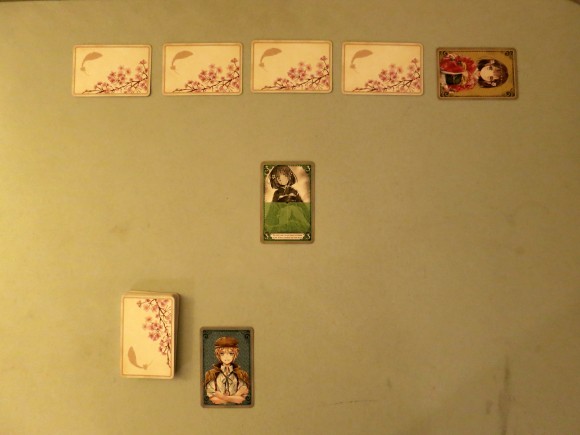
I’m going to concentrate on rules and strategy for things that happen within a single dream first for each player, then talk about rules and notes for a full three Dream game.
Feth’s Turn
- Feth deals as many cards as he wants into a “Memory Row” in front of him.
- Whenever he decides he is done, he moves any revealed Ravens directly below Memory Row into a “Raven Row.”
- Feth then plays as many cards as he wants from Memory row into the Atman.
- Feth’s turn then ends, and any cards left in Memory Row are discarded.
At any point during his turn, Feth may use the powers listed on any face up cards in Ren’s Poem.
Key rules for Feth
- Cards added to the Atman must:
- be in the same orientation as cards already in the Atman.
- overlap at least one shaded area with a card already in the Atman.
- have any sections that overlap with cards already in the Atman be of like type (shaded vs clear).
- not directly completely cover another card.
- In the above pictures, after Feth adds the purple 5 to the Atman the green 3 is completely covered, and thus does not count as part of the Atman until/unless it is later uncovered again.
- If ever all five Ravens are in Raven Row, the game ends immediately.
- Whenever cards are discarded, if they match the color of a Raven in Ravens Row, they go underneath that Raven instead of into the discard pile.
- Exception to the above: any cards in Memory Row directly above a Raven already in Raven Row are “safe.” Safe cards go to the discard pile regardless of color when discarded, and safe Ravens get discarded instead of moving into Raven’s Row.
 Example of Fen’s play area. If his turn ended like this, the red 5 would be “safe” and would go to the discard pile (with the purple 5). The yellow 1 is not “safe,” and would be placed under the yellow Raven.
Example of Fen’s play area. If his turn ended like this, the red 5 would be “safe” and would go to the discard pile (with the purple 5). The yellow 1 is not “safe,” and would be placed under the yellow Raven.
- When Feth uses a card from Ren’s Poem, that card is turned sideways and cannot be used again (unless refreshed).
- If a card in the Atman is completely covered, it no longer counts as being part of the Atman unless/until it is visible again.
- Reliving Memories (important): whenever Feth manages to play cards to the Atman such that an uninterrupted group of cards of the same color totaling exactly 7 is formed, he “relives one of Ren’s memories.”
- The matching colored Raven is chased away from Raven Row (if there) for the rest of the Dream. Any cards under the Raven move to the discard pile.
- Ren reveals one Heart card that matches the color of the relived memory.
- If she does, all cards in that row are “refreshed” (turned vertical) and Feth can use their powers again.
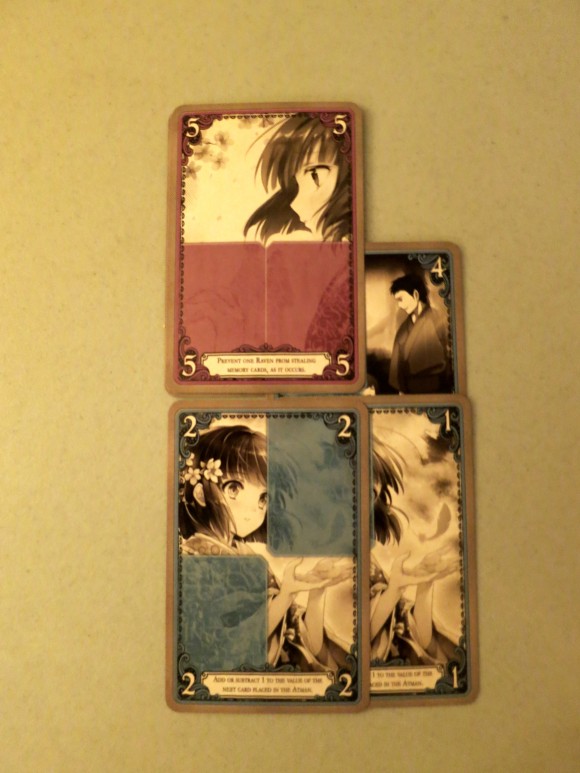
Beginning strategy notes for Feth
- Balance drawing enough cards to provide Ren with good options to complete her poem, and being wary of drawing all five Ravens or emptying the deck.
- Make sure he can always play at least one card to the Atman.
- Pay attention to Ren’s clues, and as the dream progresses try to guess which colors should be present in the Atman and which colors he should be trying not to play and/or covering up.
Ren’s Turn
Mechanically Ren’s turns are much simper than Feth’s
- Ren draws any one visible card from the Atman and either adds it to the current row of her poem or discards it. That’s it.
Key rules for Ren
- Ren is trying to add cards to the rows of her Poem such that the totals are 7-7-7-5.
- Totals include Ren’s Heart cards.
- Rows must be completed in order.
- For example, to begin the Dream Ren can only play cards she draws from the Atman to the first row of her Poem.
- Once she plays a card to that first row that brings the sum of all card values in that row to 7, one the following turn she will start playing cards to the second row of her Poem.
- If Ren adds a card to a row that matches the color of the Heart card for that row, the Heart card is revealed to Feth.
- Whenever a row is completed, Ren informs the Feth player of that fact.
- When the fourth row is completed, Ren tells Feth whether the Dream is over or not ( depending on whether or not the Atman only shows colors in her Heart cards).
- If not, play continues until the players accomplish that second goal or until a loss condition is met.
- Partially covered cards are fine to draw. Any cards over or under it remain in position, and any previously hidden cards uncovered by Ren’s draw are now considered part of the Atman again.
- Cards Ren discards that match the color of a Raven in Raven Row go underneath the Raven as normal.
- If Ren chooses to draw a card that can be played to the current line of her Poem, she must play it there (and cannot discard it).
- Whenever the Atman is “split,” Ren is the one who decides which part(s) of the Atman are discarded, regardless of whose turn it happens on.
- The Atman is split when it consists of more than one section that are not visibly connected by any overlapping cards.
- Ren chooses one section to keep, and all others are discarded (cards are placed under Ravens as normal).
- Remember – cards not visible are not considered part of the Atman, so there may be hidden cards underneath those being discarded that will remain on the table / become part of the Atman once the discarded sections have been removed.
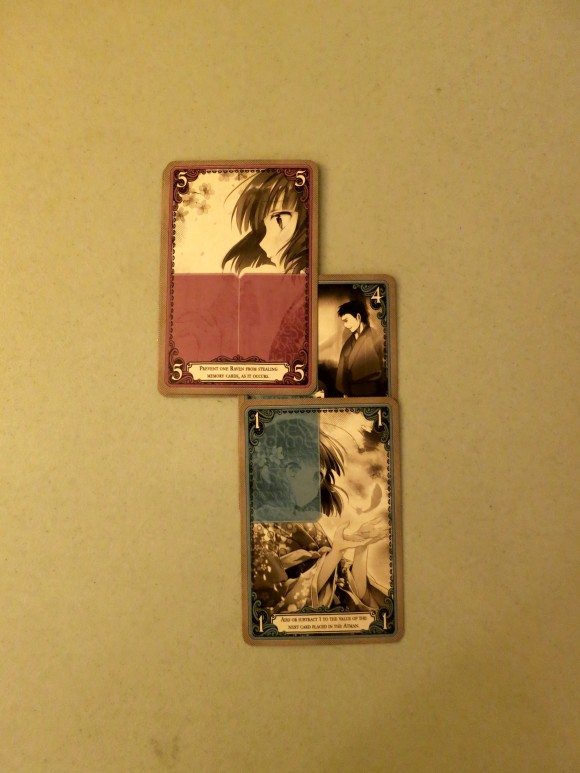
Example pic of a simple Atman that could be split – if Ren draws the blue 4, the purple 5 and blue 1 will be unconnected. Ren will then choose one to discard.
Beginning strategy notes for Ren
With Feth, a player need to be mindful of several options and rules and focus on aiding Ren. In contrast, Ren’s role is to make the most out of removing a single card from the Atman each turn, both in terms of progressing towards their goals and in providing as much information to Feth as possible.
- Removing cards from the Atman primarily of colors that aren’t in Ren’s Heart is a good way to clue Feth in about what colors can’t be in the Atman at the end of the Dream.
- Removing/discarding high value cards from the Atman can help indicate what value(s) are need for the current row of the Poem.
- For example, if the Atman only shows values of 3 and higher, and Ren draws and discards a 3, the Feth player knows she couldn’t play the 3 in her row because the total of the row would go over 7. That also means she can’t play any of the 4s or 5s in the current row.
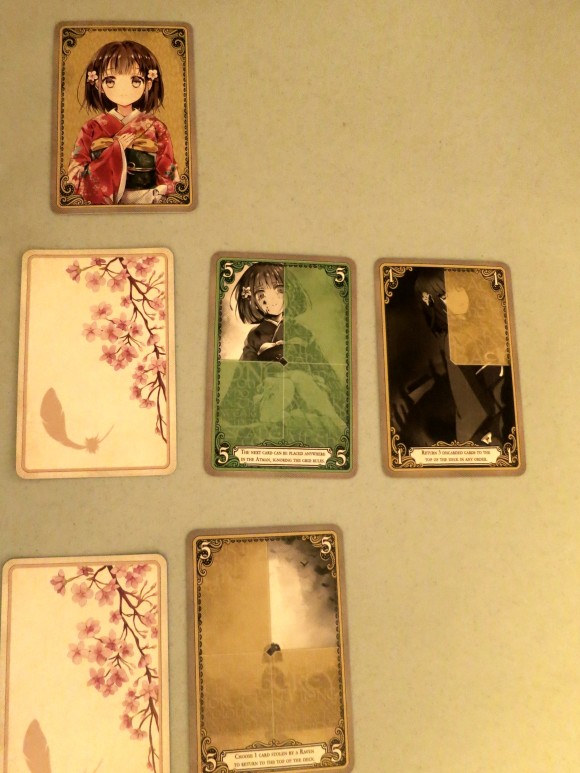
Example of part of Ren’s Poem during game. From the above pic Feth knows:
- The first Heart card is not yellow or green, and the second is not yellow.
- The Heart card for the first row must be a 1.
- If Ren has not announced the second row is complete, that heart card must also be a 1. If she has said it’s complete, the Heart card must be a 2.
The game beyond finishing the first dream
In between Dreams
When the players successfully complete a Dream, three key things happen:
- Any cards underneath Ravens in Raven rows are “eaten” (removed from the game), and the players will not have use of them for the remaining Dreams.
- Any Ravens chased away by Feth “reliving a memory” return to Raven Row.
- If this causes all five Ravens to be in the row, the players have lost.
- Any of Ren’s Heart cards that were revealed by Feth “reliving a memory” (NOT those revealed by Ren playing a card of the same color to that Heart card’s row) go into a “score pile” that is set aside until the final Dream.
As such Feth’s deck generally decreases in size from Dream to Dream, increasing the difficulty as the game goes on.
Final Dream
The players’ last attempt to complete Ren’s Poem and match the Atman to the colors of her Heart has additional challenges and advantages for the players. When learning the game I’d recommend not worrying about this section too much until you get there, except to understanding adding some cards to Ren’s score pile throughout the game is important.
Restrictions:
- Ren must complete a line of her Poem on EVERY TURN, or the players lose.
- The Atman colors must match the colors of Ren’s Heart cards at the end of Ren’s fourth turn, as the players will get no additional turns to accomplish that.
Extra abilities:
- In addition to drawing a card from the Atman and playing it on her turn, Ren may play as many cards from her score pile as she wants to help her complete the row.
- Cards under any Ravens Feth chases away during this Dream go into Ren’s score pile instead of the discard pile.
Hopefully this will be a useful reference. Feel free to let me know in the comments if anything is unclear.



7 replies on “Ravens of Thri Sahashri Beginner’s Guide”
I haven’t read your post yet, but already thank you for it. I’ll be reading it tomorrow.
We only played one dream and got so confused and borderline frustrated that we stopped so we wouldn’t GET frustrated. The rulebook was not clear, nor was it laid out in a manner that we found helpful. It also didn’t answer a LOT of questions that we both had.
That being said, even if we end up hating the game, it was still worth buying for the art on the cards 🙂
LikeLike
You’re welcome. Hope it helps, and that the game goes better the second time around. Please feel free to ask any questions. 🙂
I felt the exact same way about the art when I got the game (although in my case I did end up enjoying it, which was even better).
LikeLiked by 1 person
Well, even though things were clearer this time around, the math was a bit more and that didn’t work for us. I like numbers, but my wife,not so much. It did help a lot that it was cooperative but I foresee one more game and then it’ll sit on our shelf until we give it away or something 🙂
Thanks for bringing this to my attention though. It is good to dip my toes into other pools besides the book one.
LikeLike
Sorry it didn’t work out, but hope you had at least a little fun trying. Let me know when/if you’re in the mood for gaming again and I’ll find something less mathy to suggest.
LikeLiked by 1 person
It was fun trying something new, together, even if the game itself wasn’t down our alley.
part of it is also that I’m a pretty wordy person and so to have to talk about non-game stuff was pretty hard on me 😀
LikeLike
[…] Raven’s of Thri Sahashri Beginner’s Guide 549 […]
LikeLike
[…] Raven’s of Thri Sahashri Beginner’s Guide 1,212 […]
LikeLike